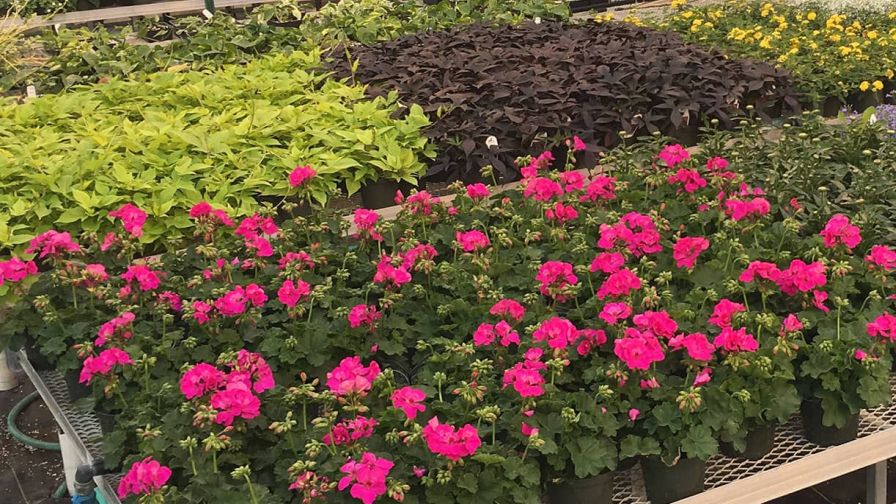
USDA AgCensus Floriculture Trends | Resource Innovation Institute (RII)
The controlled environment agriculture (CEA) market is evolving to meet shifting retail and commercial demands and is experiencing great overall growth.
In a recent webinar, Resource Innovation Institute (RII) and CEA industry experts Rob Eddy and Carmen Azzaretti offered a deep dive into RII’s “CEA in The Census of Agriculture” report, sharing insights on the blooming U.S. floriculture market.
The July 9, 2024, webinar explored some trends in the covered greenhouse/indoor farm floriculture market, highlighting growth markets and crop changes between 2012 and 2022, the most recent year for which data is available.
Here are some of the key takeaways from the presentation.
1. Florida, California, and Texas Still Lead the Country in Floriculture Production
Florida has the highest number of operations and area and California is right behind it. Florida has more than 295 million square feet of floriculture area in production, nearly triple California’s covered floriculture footprint (more than 107 million square feet).
The top three floriculture crops by area in Florida are cut flowers (99.4 million square feet), indoor foliage (94.6 million square feet), and bedding/garden plants (55.1 million square feet). In California, it’s cut flowers (41.1 million square feet), potted flowering crops (33.1 million square feet), and bedding/garden plants (15.9 million square feet).
The reasons are fairly clear: Ideal climates and energy-efficiency policies make cut flower production in those markets highly efficient. Additionally, nearby access to large population centers helps growers minimize shipping costs.
2. Arizona and Alabama See an Increase in Operations and Footprint
Alabama and Arizona had significant growth in floriculture cultivation from 2012 to 2022. This tracks with economic development initiatives in those states targeting growth industries like CEA.
Arizona had only 74 operations with just under 1.6 million square feet of floriculture crops grown under protection in 2012. By 2022, those numbers ballooned to 116 operations across nearly 7.3 million square feet of canopy, a more than 364% increase in area.
For its part, Alabama had 200 floriculture operations cultivating 8.8 million square feet of floriculture crops grown under protection in 2012. By 2022, 369 operations were growing more than 12 million square feet of floriculture crops under protection, a more than 36% increase in total area.
Alabama’s proximity to Florida gives it greater access to large retail and commercial markets. For example, Dixie Green in Centre, AL, operates 12 acres of heated greenhouse space and grows everything from ferns and fall mums to calla lilies, according to Southeast AgNet Radio Network. “The company is also a major supplier to Walt Disney World, which buys more than 80,000 poinsettias and caladiums for the Magic Kingdom and Epcot,” according to the news report.
3. The Floriculture Industry Is Diversifying Both in Crops and in Participants
Many states experienced growth in the number of operations, yet a reduction in total area. This is potentially a sign that many of the larger farms are struggling and shuttering operations and are being replaced by smaller farms. For example, there was an 80% increase nationwide in the number of operations growing cut flowers, but a 30% decrease in the area dedicated to the crop category. All states saw an increase in the number of operations growing cut flowers except Florida and Hawaii; many states had minimal area growth, again indicating many smaller operations serving local communities and eclectic tastes.
Additionally, a greater number of CEA operations seemingly are growing a variety of crops, therefore reducing the footprint for floriculture in favor of more revenue-generating crops like vegetables and fresh-cut herbs. According to USDA AgCensus data, there was a 211% increase in greenhouse area dedicated to vegetables and herbs between 2012 and 2022 (from 42.8 million square feet to 133.3 million square feet), and the number of operations growing them exploded from 5,268 to 11,465.
Indoor foliage saw a large increase in both the number of operations and the total growing area. There have been big increases in indoor foliage areas and operations in Iowa and Virginia, big increases in operations in Idaho, North Dakota, South Dakota, and New York, and a drop in size in Idaho. This could be partially due to the COVID-19 pandemic driving many to work from home and add houseplants to their decor.
The CEA market data offered in the USDA AgCensus presents a broad and in-depth portrait of a growing industry with the ability to respond to consumer demand shifts that are adaptable to many markets and climates. As the USDA is already working on its 2027 reporting, it will be interesting to see how post-pandemic trends settle and how the continued effects of climate change impact CEA and agriculture as a whole.
For additional insights into floriculture trends from USDA AgCensus data, please read the original article found on the RII website.

